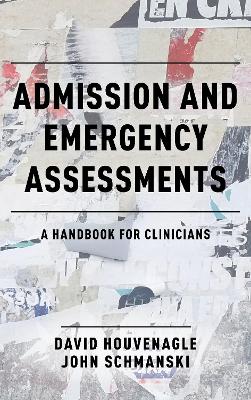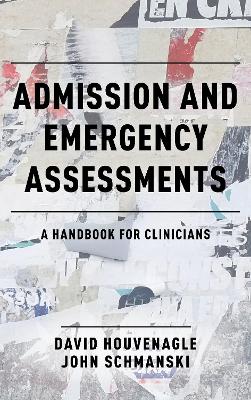Admission and Emergency Assessments
 portes grátis
portes grátis
Admission and Emergency Assessments
A Handbook for Clinicians
Schmanski, John; Houvenagle, David
Rowman & Littlefield
11/2024
248
Mole
9781538198049
Pré-lançamento - envio 15 a 20 dias após a sua edição
Descrição não disponível.
Authors' Note
Acknowledgments
Chapter 1: Introduction
Comment on Diversity
Chapter 2: The Purpose of the Interview
Criteria
The Patient's or Family's Agenda
Reconciling Criteria and Motivation
Concluding Thoughts
Chapter 3: The Reality of the Emergency and Assessment Interview: Challenges to Validity and Reliability
The Deciphering Filters: The Assessment Questions, Observations, and Criteria
The Curve of Ability
The Different Levels of Motivation
Obligations and External Pressure
The External Factors of the Collateral Sources and Climate
Vignettes
Concluding Thoughts
Chapter 4: Interviewing Skills and Patterns
The Structured Versus the Unstructured Interview Pattern
Joining with the Patient: Formality, Tone of Voice, and Confidence
Case Vignettes
Concluding Thoughts
Chapter 5: Suicide Assessment
The Criteria of Suicide Assessment: Immediate versus Potential Safety Risk
Applying the Curve of Ability
The Value of Collateral Sources
Becoming Accustomed to Asking Patients about Suicide
Vignettes of Suicide Assessment
Concluding Thoughts
Chapter 6: The Disruptive, Aggressive, and Anti-Social Patient
Anger Due to Unmet Human Needs
Risks Associated with the Disruptive, Aggressive, and/or Anti-Social Patient
Safety Measures to Protect Therapists, Patients, and Guests
Concluding Thoughts
Chapter 7: Assessing Children and Adolescents
Interviewing Considerations
The Immediate Safety Risk
Out of Control, Reckless, Risky Behavior
Assets and Liabilities of the Caregiver in the Assessment Process
Legal Obligations
Vignettes
Chapter 8: Substance Use Assessment
Taking the History
Scope of Drug and Alcohol Types
Criteria for Hospital Admission
Immediate Safety Risk versus Potential Safety Risk
Concluding Thoughts
Chapter 9: Language Interpretation
Legal and Ethical Considerations
Expectations for the Interview
Telehealth
Vignettes
Working with the Interpreter
Concluding Thoughts
Chapter 10: Staffing with the Doctors
The Script and Its Elements
The Structure of the Script
Delivery of the Script: Tone and Pace
Getting to Know the Doctors You Work with
When a Doctor Passes?
The Risk of Bad Recommendations
Extraordinary Situations
Vignettes
Concluding Thoughts
Chapter 11: Telling People "No"
Reviewing Boundaries
Understanding Assertiveness
Vignettes
Concluding Thoughts
Chapter 12: Insurance Prior Authorizations
Prior Authorization as an Element of Utilization Management
The Phone Call Prior Authorization
The Fax Authorization
The Online Authorization
The Peer-to-Peer or Physician Review
What If There Is a Denial?
Concluding Thoughts
Chapter 13: The High Utilizer
Describing High Utilizers
Overall Perspective
Serial Behavioral Patterns
Challenges to Interviewing
Strategies for Interviewing Difficult High Utilizers
Sometimes You Can Divert the High Utilizer
Vignettes
Concluding Thoughts
Chapter 14: Concluding Thoughts: Learning and Appreciating the Value of Communication
John's Experiences
David's Experience
References
Index
About the Authors
Acknowledgments
Chapter 1: Introduction
Comment on Diversity
Chapter 2: The Purpose of the Interview
Criteria
The Patient's or Family's Agenda
Reconciling Criteria and Motivation
Concluding Thoughts
Chapter 3: The Reality of the Emergency and Assessment Interview: Challenges to Validity and Reliability
The Deciphering Filters: The Assessment Questions, Observations, and Criteria
The Curve of Ability
The Different Levels of Motivation
Obligations and External Pressure
The External Factors of the Collateral Sources and Climate
Vignettes
Concluding Thoughts
Chapter 4: Interviewing Skills and Patterns
The Structured Versus the Unstructured Interview Pattern
Joining with the Patient: Formality, Tone of Voice, and Confidence
Case Vignettes
Concluding Thoughts
Chapter 5: Suicide Assessment
The Criteria of Suicide Assessment: Immediate versus Potential Safety Risk
Applying the Curve of Ability
The Value of Collateral Sources
Becoming Accustomed to Asking Patients about Suicide
Vignettes of Suicide Assessment
Concluding Thoughts
Chapter 6: The Disruptive, Aggressive, and Anti-Social Patient
Anger Due to Unmet Human Needs
Risks Associated with the Disruptive, Aggressive, and/or Anti-Social Patient
Safety Measures to Protect Therapists, Patients, and Guests
Concluding Thoughts
Chapter 7: Assessing Children and Adolescents
Interviewing Considerations
The Immediate Safety Risk
Out of Control, Reckless, Risky Behavior
Assets and Liabilities of the Caregiver in the Assessment Process
Legal Obligations
Vignettes
Chapter 8: Substance Use Assessment
Taking the History
Scope of Drug and Alcohol Types
Criteria for Hospital Admission
Immediate Safety Risk versus Potential Safety Risk
Concluding Thoughts
Chapter 9: Language Interpretation
Legal and Ethical Considerations
Expectations for the Interview
Telehealth
Vignettes
Working with the Interpreter
Concluding Thoughts
Chapter 10: Staffing with the Doctors
The Script and Its Elements
The Structure of the Script
Delivery of the Script: Tone and Pace
Getting to Know the Doctors You Work with
When a Doctor Passes?
The Risk of Bad Recommendations
Extraordinary Situations
Vignettes
Concluding Thoughts
Chapter 11: Telling People "No"
Reviewing Boundaries
Understanding Assertiveness
Vignettes
Concluding Thoughts
Chapter 12: Insurance Prior Authorizations
Prior Authorization as an Element of Utilization Management
The Phone Call Prior Authorization
The Fax Authorization
The Online Authorization
The Peer-to-Peer or Physician Review
What If There Is a Denial?
Concluding Thoughts
Chapter 13: The High Utilizer
Describing High Utilizers
Overall Perspective
Serial Behavioral Patterns
Challenges to Interviewing
Strategies for Interviewing Difficult High Utilizers
Sometimes You Can Divert the High Utilizer
Vignettes
Concluding Thoughts
Chapter 14: Concluding Thoughts: Learning and Appreciating the Value of Communication
John's Experiences
David's Experience
References
Index
About the Authors
Este título pertence ao(s) assunto(s) indicados(s). Para ver outros títulos clique no assunto desejado.
case workers;clinical assessment;clinical interviewing;emergency intake assessment;psychiatric emergencies
Authors' Note
Acknowledgments
Chapter 1: Introduction
Comment on Diversity
Chapter 2: The Purpose of the Interview
Criteria
The Patient's or Family's Agenda
Reconciling Criteria and Motivation
Concluding Thoughts
Chapter 3: The Reality of the Emergency and Assessment Interview: Challenges to Validity and Reliability
The Deciphering Filters: The Assessment Questions, Observations, and Criteria
The Curve of Ability
The Different Levels of Motivation
Obligations and External Pressure
The External Factors of the Collateral Sources and Climate
Vignettes
Concluding Thoughts
Chapter 4: Interviewing Skills and Patterns
The Structured Versus the Unstructured Interview Pattern
Joining with the Patient: Formality, Tone of Voice, and Confidence
Case Vignettes
Concluding Thoughts
Chapter 5: Suicide Assessment
The Criteria of Suicide Assessment: Immediate versus Potential Safety Risk
Applying the Curve of Ability
The Value of Collateral Sources
Becoming Accustomed to Asking Patients about Suicide
Vignettes of Suicide Assessment
Concluding Thoughts
Chapter 6: The Disruptive, Aggressive, and Anti-Social Patient
Anger Due to Unmet Human Needs
Risks Associated with the Disruptive, Aggressive, and/or Anti-Social Patient
Safety Measures to Protect Therapists, Patients, and Guests
Concluding Thoughts
Chapter 7: Assessing Children and Adolescents
Interviewing Considerations
The Immediate Safety Risk
Out of Control, Reckless, Risky Behavior
Assets and Liabilities of the Caregiver in the Assessment Process
Legal Obligations
Vignettes
Chapter 8: Substance Use Assessment
Taking the History
Scope of Drug and Alcohol Types
Criteria for Hospital Admission
Immediate Safety Risk versus Potential Safety Risk
Concluding Thoughts
Chapter 9: Language Interpretation
Legal and Ethical Considerations
Expectations for the Interview
Telehealth
Vignettes
Working with the Interpreter
Concluding Thoughts
Chapter 10: Staffing with the Doctors
The Script and Its Elements
The Structure of the Script
Delivery of the Script: Tone and Pace
Getting to Know the Doctors You Work with
When a Doctor Passes?
The Risk of Bad Recommendations
Extraordinary Situations
Vignettes
Concluding Thoughts
Chapter 11: Telling People "No"
Reviewing Boundaries
Understanding Assertiveness
Vignettes
Concluding Thoughts
Chapter 12: Insurance Prior Authorizations
Prior Authorization as an Element of Utilization Management
The Phone Call Prior Authorization
The Fax Authorization
The Online Authorization
The Peer-to-Peer or Physician Review
What If There Is a Denial?
Concluding Thoughts
Chapter 13: The High Utilizer
Describing High Utilizers
Overall Perspective
Serial Behavioral Patterns
Challenges to Interviewing
Strategies for Interviewing Difficult High Utilizers
Sometimes You Can Divert the High Utilizer
Vignettes
Concluding Thoughts
Chapter 14: Concluding Thoughts: Learning and Appreciating the Value of Communication
John's Experiences
David's Experience
References
Index
About the Authors
Acknowledgments
Chapter 1: Introduction
Comment on Diversity
Chapter 2: The Purpose of the Interview
Criteria
The Patient's or Family's Agenda
Reconciling Criteria and Motivation
Concluding Thoughts
Chapter 3: The Reality of the Emergency and Assessment Interview: Challenges to Validity and Reliability
The Deciphering Filters: The Assessment Questions, Observations, and Criteria
The Curve of Ability
The Different Levels of Motivation
Obligations and External Pressure
The External Factors of the Collateral Sources and Climate
Vignettes
Concluding Thoughts
Chapter 4: Interviewing Skills and Patterns
The Structured Versus the Unstructured Interview Pattern
Joining with the Patient: Formality, Tone of Voice, and Confidence
Case Vignettes
Concluding Thoughts
Chapter 5: Suicide Assessment
The Criteria of Suicide Assessment: Immediate versus Potential Safety Risk
Applying the Curve of Ability
The Value of Collateral Sources
Becoming Accustomed to Asking Patients about Suicide
Vignettes of Suicide Assessment
Concluding Thoughts
Chapter 6: The Disruptive, Aggressive, and Anti-Social Patient
Anger Due to Unmet Human Needs
Risks Associated with the Disruptive, Aggressive, and/or Anti-Social Patient
Safety Measures to Protect Therapists, Patients, and Guests
Concluding Thoughts
Chapter 7: Assessing Children and Adolescents
Interviewing Considerations
The Immediate Safety Risk
Out of Control, Reckless, Risky Behavior
Assets and Liabilities of the Caregiver in the Assessment Process
Legal Obligations
Vignettes
Chapter 8: Substance Use Assessment
Taking the History
Scope of Drug and Alcohol Types
Criteria for Hospital Admission
Immediate Safety Risk versus Potential Safety Risk
Concluding Thoughts
Chapter 9: Language Interpretation
Legal and Ethical Considerations
Expectations for the Interview
Telehealth
Vignettes
Working with the Interpreter
Concluding Thoughts
Chapter 10: Staffing with the Doctors
The Script and Its Elements
The Structure of the Script
Delivery of the Script: Tone and Pace
Getting to Know the Doctors You Work with
When a Doctor Passes?
The Risk of Bad Recommendations
Extraordinary Situations
Vignettes
Concluding Thoughts
Chapter 11: Telling People "No"
Reviewing Boundaries
Understanding Assertiveness
Vignettes
Concluding Thoughts
Chapter 12: Insurance Prior Authorizations
Prior Authorization as an Element of Utilization Management
The Phone Call Prior Authorization
The Fax Authorization
The Online Authorization
The Peer-to-Peer or Physician Review
What If There Is a Denial?
Concluding Thoughts
Chapter 13: The High Utilizer
Describing High Utilizers
Overall Perspective
Serial Behavioral Patterns
Challenges to Interviewing
Strategies for Interviewing Difficult High Utilizers
Sometimes You Can Divert the High Utilizer
Vignettes
Concluding Thoughts
Chapter 14: Concluding Thoughts: Learning and Appreciating the Value of Communication
John's Experiences
David's Experience
References
Index
About the Authors
Este título pertence ao(s) assunto(s) indicados(s). Para ver outros títulos clique no assunto desejado.







